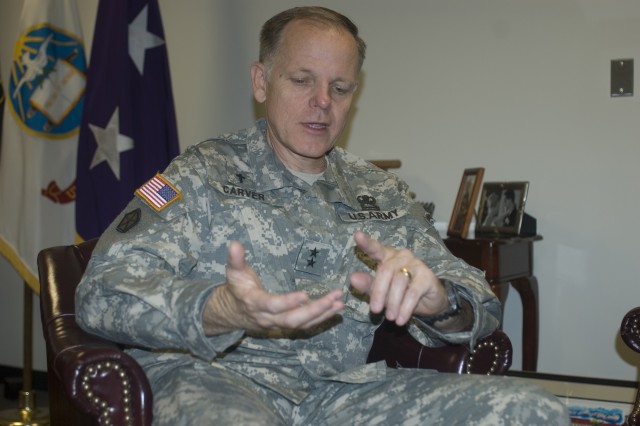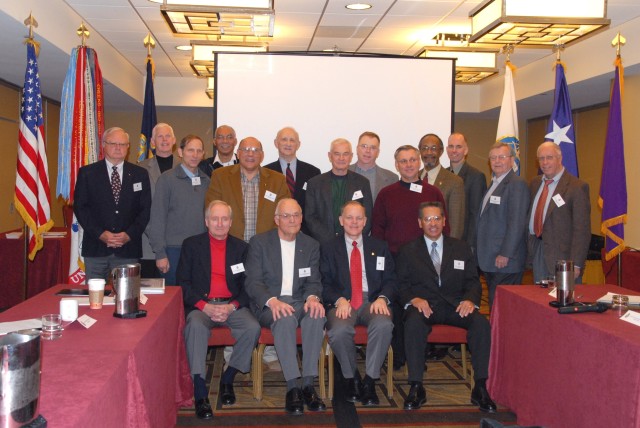WASHINGTON (Army News Service, Feb. 21, 2008) - As the Army's chaplaincy focuses on expanding services to wounded warriors and redeploying Soldiers, 15 former chiefs of chaplains gathered in Arlington, Va., for a "Graybeard Conference" Feb. 15 to discuss lessons learned from their tenures and relate them to the biggest concerns for today's Army.
Maj. Gen. Douglas L. Carver, the Army's current chief of chaplains, invited the former chaplains from the active Army, National Guard and Army Reserve in order to learn from their 40 years of combined experience at the helm of the chaplaincy and update them on the Army's current goals, priorities and challenges.
'
"There's a scripture in the bible that says there's nothing new under the sun, so I know that what I'm experiencing today as a leader is something that I can learn from those who have gone before me -- similar challenges that they've faced during the life and the history of the Army and the nation. I think it's also important for us to hear the collective wisdom of those who have been in this leadership position before, to hear their thoughts, their ideas, just to ensure we're doing the best we can to support our Soldiers and Families during a time of war."
The chaplains did in fact recall many of the same challenges facing today's chaplaincy, especially a lack of personnel and resources, although with repeated deployments in what Army Chief of Staff Gen. George W. Casey has called an "era of persistent conflict," the chaplaincy, Carver said, is probably the most stretched it has ever been. Commanders downrange, he said, fight over chaplains and their time.
In response to concerns about the toll constant deployments, casualty missions, and ministering to wounded Soldiers and their Families is taking on chaplains, Carver assured the room that the Chaplain Corps is launching several 'Care for the Caregiver' initiatives to address the issue of the spiritual resilience of chaplains as part of the chaplaincy's strategic campaign plan.
"Every chaplain needs a chaplain," he said in an August 2007 interview. Chaplains see and hear so much in their roles as pastors and counselors, in addition to the stress and danger of any deployment, that they are in real danger of developing compassion fatigue as well as battlefield injuries and post traumatic stress disorder.
The Army is also increasingly turning to the chaplaincy for help in suicide prevention, another major concern of the chaplains - 2006 had the highest suicide rate since 1990 and the numbers are still out for 2007 - and Family and couples programs, such as the successful Strong Bonds program, for which they have requested $37 million this year alone.
According to Col. David Reese, director for ministry initiatives at the Office of the Chief of Chaplains, chaplains have already been assigned to some of the Warrior Transition Brigades and will be assigned to all WTUs down to the battalion level to provide pastoral care and religious support for wounded Soldiers and their Families. If necessary, he said, they will recall retired chaplains to help.
He added that the Strong Bonds program of marriage retreats is also being expanded to meet the specific needs of wounded Soldiers and their Families. In addition to the regular curriculum focusing on communication skills, the program will be handicapped accessible and provide forums on challenges specific to them, such as grief and loss. Some chaplains have already begun offering specific weekends to wounded warriors and their Families on an informal basis.
With most terrorists motivated by ideological and religious means, chaplains are also gaining importance as religious advisors to commanders. While the chaplains told Carver it was important to continue to educate chaplains about other religions, which many of them did not receive, they cautioned him against allowing chaplains to become too spread out or allowing them to fill roles other Soldiers can. The most important thing, he agreed, was taking care of people.
Reserve-component Soldiers and chaplains were of special concern for some of the former chief chaplains, who had themselves been in the Reserve and National Guard. The Army has to make sure it cares for the returning Soldiers properly, they said. Some reserve-component chaplains, they said, are also put in the terrible position of choosing between their military constituencies and civilian congregations, as some congregations have refused to let them deploy a second or third time.
The Army has 3,000-3,500 active-duty and reserve-component chaplains and Carver has requested another 446 chaplains and chaplains' assistants as the Army expands by more than 74,000 Soldiers over the next few years.
Related Links:
Program Builds Strong Army Marriages
New Archbishop Pledges to Find More Chaplains




Social Sharing